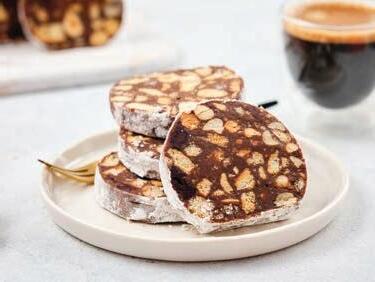
4 minute read
Sweet things
by Martin
CAKES AND BISCUITS, TARTS AND FLANS, BUTTERSOFT PASTRY, TRICKLES OF ICING. SOFT MERINGUES, SUGARED FRUIT, CREAM AND CHOCOLATE. CALORIE COUNT HUGE, BUT MAKE IT AN OCCASIONAL TREAT, AND SPOIL YOURSELF PORTUGUESE-STYLE
Words: LAURA SHEA
THE WELL-KNOWN joy of a warm Pastel de Nata in the morning with a strong coffee is cherished for a reason; it is perfection! Found throughout the country, these tarts are the most recognisable option in any shop or pastelaria. Another common sight is the Bolo de Arroz or Bolo de Noz, those lovely little muffin-shaped cakes, ideal at any time of the day. The chocolate lover’s dream is the salame, named for its resemblance to a salami sausage, but don’t let that put you off. Most often served in slices in a gold foil wrapper, this chunk of pure sweetness is made with crushed up Maria biscuits and a thick chocolate ganache. But these better-known treats aside, there is a huge array of incredible edibles that your sweet tooth will thank you for.
Local specialities
Ovos Moles de Aveiro need a special mention as the country’s first sweet to be awarded the Protected Geographical Indication certification. Put simply, this ensures that any Ovo you get to sample will be following the authentic recipe. These gorgeous little bites are made using a light casing (originally communion wafers) and are usually shaped like sea shells and fish. They were created by nuns so as not to waste egg yolks (the whites were used to clean their habits) and sold to raise much-needed money for the convents.
Travesseiro de Sintra and Pastel de Santa Clara are similar, both made from light puff pastry with a filling of a rich cream made from eggs and almonds. The Travesseiro de Sintra is formed to make a pillowy shape and is a larger option for those with a serious sweet tooth. Many argue that you cannot get the true experience unless you taste a Travesseiro in Sintra itself, and the pastelaria Casa Piriquita is known as the spot to do this, having created the dish in the 1940s. The Santa Clara version has a much older history, originating in the town of Coimbra at the convent of Santa Clara in the 16th century. Born from the desire to not waste the yolks, just as with the Ovos Moles, this cake is delicate, and deliciously sweet like marzipan. The pastry is moulded into a half moon shape similar to an empanada, or used to create a cup, with the filling placed in the middle before baking.



Tigeladas are a rich, custardy option, great for sharing over an afternoon coffee. This cake is something like a crème brûlée – caramelised, firm and flavourful thanks to the addition of cinnamon, and served either in the terracotta bowl it was baked in – in a wood-fired oven – or turned out onto a plate. It is surprisingly light as there is no pastry, and packs a sweet punch with a great texture. This delicacy is so popular that there is a festival on 1 May, the Festa Das Tigeladas, that celebrates its long history and creation in the convents of the Abrantes region.
If you are vegan, the Queijo de Figo is here to save the day. With a base of ground almonds and figs, it is a popular Algarvean treat, shaped like a wheel of cheese.

When you hear the ingredients of our next cake, you might turn your nose up and think that this couldn’t possibly make a delicious dessert, but you would be wrong! The Pastel de Feijão looks very similar to a pastel de nata at first glance, but you will notice a different texture inside the pastry casing. This is thanks to the star of the mix, the navy bean or haricot bean. If you love beans on toast, then try this pastel and discover that they taste just as comforting and lovely sweet as they do savoury. Believed to have been invented by nuns in the 19th century, this cake is a delight best enjoyed outside your favourite coffee shop on a sunny afternoon.
Is
Truly festive
For the history fans, there are a couple of fantastic choices to nibble on when you find them. A very common sight around Christmas time, the Bolo Rei and Bolo Rainha, are two Portuguese versions of the traditional king cakes found across the world. The golden dough, the fragrant spice and the flash of colour all symbolise the gifts of the Wise Men, but the origins of these cakes can be traced back to the Roman festivals held to mark the end of the winter solstice.
The Bolo Rei contain two surprises – find the hidden charm and you’ll have good luck; but find the fava bean and you’ll be responsible for buying the cake the following year. The bolos you find locally will be large and round, resembling a crown, decorated with brightly coloured crystalised fruits and nuts. You will also see a version lacking the fruit, and more focused on a selection of nuts, and this is the Bolo Rainha. Fluffy, soft and filled with spices like cinnamon and nutmeg both cakes are a must have at any gathering during December and January.

If you happen to be fortunate enough to stumble upon a small, dark looking cupcake in a pastelaria, then do not miss the chance to taste the Bolo Dona Amelia. A well-known and hugely popular cake coming from the Azores, this is sweet and spicy and light. Evolved from the bolos das Indias, the cupcake was presented to King Carlos and Queen Amelia on the first visit by the monarchy to the islands. It was named in the queen’s honour and the recipe has not faltered much in over a hundred years.
Naughty but nice
And up in Amarante in the north, Bolos de São Gonçalo can be found. Better known as Doces Fálicos (phallic sweets) they are penis-shaped and doused in icing sugar and sold by the locals from carts in the street and at local festivals. And yes, they are quite delicious.










